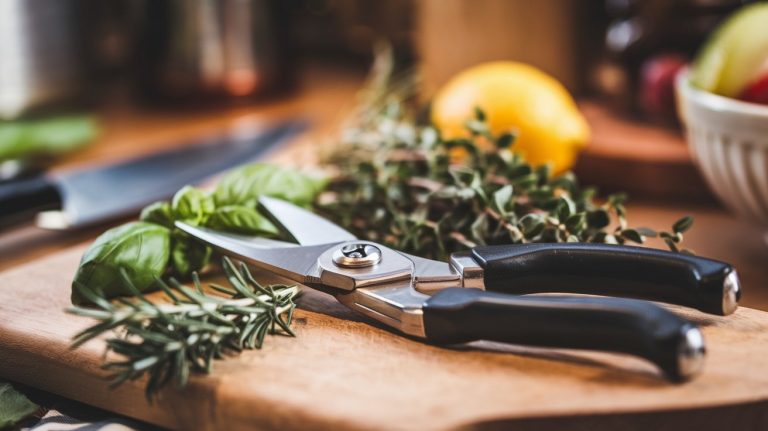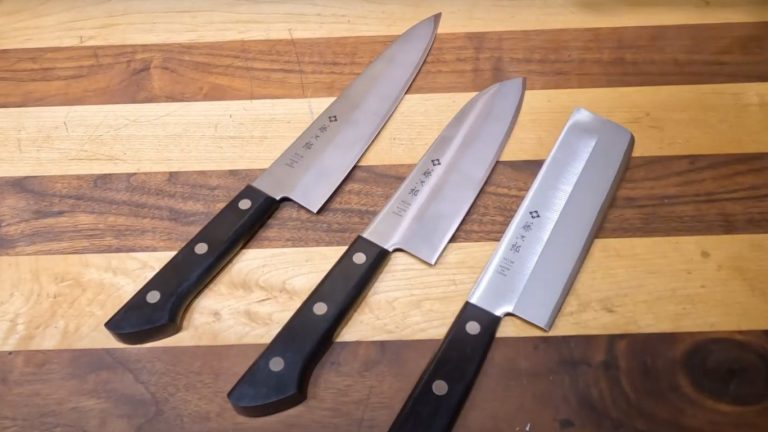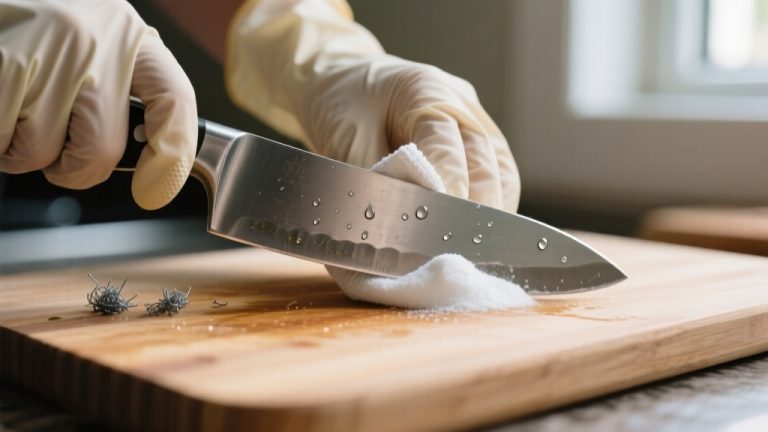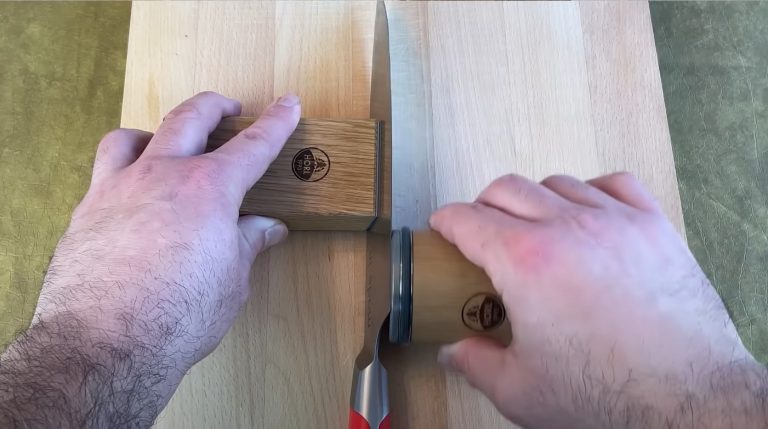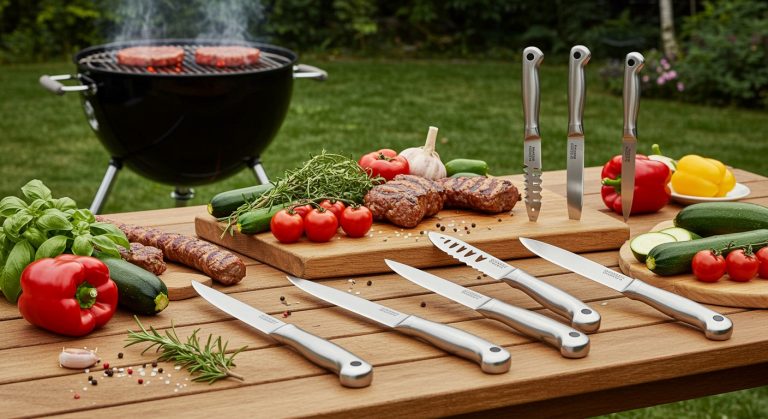Breaking Knife vs Boning Knife: What’s Best for Your Kitchen?
When deciding between a breaking knife and a boning knife, it’s important to know their unique functions.
A breaking knife has a sturdy, curved blade suited for breaking down large cuts of meat, while a boning knife boasts a smaller, flexible blade perfect for deboning poultry or fish. Their size, weight, and blade flexibility cater to different culinary tasks.
Choosing the right knife enhances your skills and elevates your cooking experience, so let’s explore more about these essential tools.
Key Takeaways
- Breaking knives are larger, heavier, and designed for cutting through tough cuts of meat, while boning knives are lighter and ideal for precision tasks.
- Breaking knives typically feature a curved blade of 8 to 12 inches, whereas boning knives have shorter blades ranging from 5 to 7 inches.
- The stiff blade of a breaking knife is suited for heavy-duty tasks, while the semi-flexible boning knife allows for maneuverability around bones.
- Breaking knives excel in breaking down large meat portions, while boning knives are essential for deboning poultry and filleting fish.
- Both knife types require regular maintenance and sharpening to ensure optimal performance and longevity in culinary tasks.
Understanding the Breaking Knife
When you’re diving into the world of meat preparation, understanding the breaking knife is essential for anyone serious about their culinary skills.
This large, sturdy knife, typically with an 8 to 10-inch long curved blade, excels at breaking down large cuts of meat. Its design allows you to easily cut through meat and bone, making it ideal for tasks like trimming brisket or slicing roasts.
Using a razor-sharp boning knife can also provide precision in cuts, particularly when working on smaller portions.
Crafted from high-carbon stainless steel, it offers durability and rust resistance, ensuring it lasts through countless uses. Breaking knives are generally more lightweight than other butcher tools, which can make them easier to handle during extensive cutting tasks.
Features of the Boning Knife
Understanding the features of a boning knife is key for anyone looking to refine their meat preparation skills. This specialized knife is designed with precision in mind, making it essential for tasks like deboning poultry or trimming fat.
Notably, the boning knife is ideal for maneuvering around joints and bones, minimizing waste during preparation. Additionally, the knife’s stiffer design allows for greater strength when working with tougher cuts of meat.
| Feature | Description |
|---|---|
| Blade Material | High-carbon stainless steel for sharpness and durability |
| Blade Length | Typically 5 to 7 inches for precise cuts |
| Blade Flexibility | Semi-flexible for maneuverability around bones |
With a pointed tip for easy piercing and an ergonomic handle for a secure grip, using a boning knife enhances your control and efficiency. Its thinner blade reduces drag, allowing you to achieve clean cuts with minimal waste, making it an invaluable tool in your kitchen arsenal.
Key Differences in Size and Weight
When choosing between a breaking knife and a boning knife, size and weight play essential roles in their effectiveness. Breaking knives feature longer and thicker blades, making them heavier and better suited for tough cuts, while boning knives prioritize a lighter, more agile design for precision tasks.
Understanding these differences helps you select the right tool for your culinary needs. Additionally, breaking knives are constructed from high-carbon European stainless steel, ensuring durability and longevity for slicing through large meat pieces.
Blade Length Comparison
While both boning and breaking knives serve essential roles in the kitchen, their blade lengths highlight key differences that cater to specific tasks.
Boning knives usually range from 5 to 7 inches, with 6 inches being the sweet spot for precision and control. In contrast, breaking knives stretch from 8 to 12 inches, leveraging their length to tackle larger cuts of meat effectively.
A boning knife’s curved blade design allows for precise, effortless cuts, enhancing its effectiveness during use. This design is similar to the asymmetrical design seen in single bevel knives, allowing for greater control and precision.
If you’re deboning chicken legs, the shorter boning knife excels in maneuverability, while the longer breaking knife provides the power needed to break down big pieces.
Weight and Balance
In the world of kitchen knives, weight and balance play essential roles in their effectiveness for specific tasks. Understanding these differences can help you choose the right knife for your needs.
Here are some key points to take into account:
- Weight: Breaking knives are heavier, designed for heavy-duty tasks, while boning knives are lighter for precision work. This lighter weight allows boning knives to excel in delicate tasks like removing small bones. Additionally, the edge retention of a knife can influence how effectively it performs during these tasks.
- Balance Point: Breaking knives balance closer to the handle for stability during strong cuts, unlike the nimbleness of boning knives.
- Handle Design: Breaking knives often feature sturdier handles to manage their weight, enhancing comfort during prolonged use.
- Usage: If you need power for cutting through bones, choose a breaking knife; for detailed work, the boning knife shines.
Blade Flexibility: Breaking vs. Boning
Understanding blade flexibility is essential when choosing between a breaking knife and a boning knife, as each serves distinct purposes in the kitchen.
Breaking knives are stiffer and less flexible, making them ideal for heavy-duty tasks like cutting through bones and large meat portions.
Rigid blades are preferred for handling impact without bending, which is crucial for durability during these tasks. Additionally, breaking knives are designed to withstand tough cuts, ensuring they remain effective over time.
On the other hand, boning knives offer varying degrees of flexibility, allowing you to navigate around bones and joints without damaging the meat.
A more flexible boning knife suits intricate detail work, while a stiffer version handles tougher cuts. The right balance of sharpness and flexibility in a boning knife enhances your performance, making it a versatile tool.
Primary Uses of the Breaking Knife
When it comes to large meat preparation, the breaking knife shines as your go-to tool for efficiently cutting down hefty portions.
Its sturdy design makes bone cutting a breeze, allowing you to tackle heavy-duty kitchen tasks with ease. Whether you’re in a professional setting or cooking at home, this knife can elevate your meat handling skills considerably.
Large Meat Preparation
While preparing large cuts of meat can seem intimidating, a breaking knife makes the process efficient and manageable. This specialized tool is perfect for tackling heavy-duty tasks with confidence.
Here are four primary uses you’ll appreciate:
- Meat Breakdown: Easily cut large cuts into smaller portions.
- Carcass Processing: Ideal for butchering whole carcasses in commercial settings.
- Tough Cuts: Handle brisket or large roasts effortlessly.
- Joint Separation: Slice through connective tissue and separate joints with precision.
With its ergonomic design and robust materials, the breaking knife not only provides control but also guarantees safety. The large, heavy-duty curved blades allow for smooth, precise cuts, making it an essential tool for any meat preparation task.
Additionally, using a knife with high-quality stainless steel ensures durability and edge retention during use.
Whether you’re prepping for a holiday feast or handling game, this knife is your go-to for large meat preparation.
Bone Cutting Efficiency
After mastering large meat preparation with a breaking knife, you’ll quickly discover its exceptional bone cutting efficiency. The long, curved blade design allows you to slice through meat and bone with ease, while the ergonomic handle provides a secure grip.
This knife’s ability to apply significant force makes it perfect for tackling thicker bones, ensuring you get the job done effectively. The right knife for cutting through bone is essential for both efficiency and safety.
Here’s a quick comparison of breaking knife features:
| Feature | Benefit | Impact |
|---|---|---|
| Blade Design | Long, curved for efficient cutting | Slices through bones easily |
| Material Selection | Durable stainless/high-carbon steel | Maintains sharpness longer |
| Force Application | Significant force for tougher bones | Cuts through with power |
| Safety Features | Ergonomic handles for control | Reduces risk of accidents |
| Task Suitability | Ideal for heavy-duty tasks | Versatile for various needs |
Heavy-Duty Kitchen Tasks
Breaking knives shine in heavy-duty kitchen tasks, making them indispensable for anyone serious about meat preparation. These specialized tools excel in various ways:
- Breaking Down Large Cuts: Perfect for trimming briskets and slicing roasts.
- Meat Portioning: Efficiently portion large cuts into smaller, manageable pieces.
- Precision Cutting: The curved blade allows for controlled cuts, reducing waste. Additionally, these knives can perform well in push/pull cuts, providing versatility in slicing techniques.
- Handling Tough Tissues: Easily slices through fat, cartilage, and sinew. Additionally, high-quality breaking knives are designed with ergonomic handles that reduce hand fatigue during prolonged use.
With features like high-carbon stainless steel and ergonomic handles, breaking knives not only enhance efficiency but also provide cleaner cuts and reduce hand fatigue.
Versatile Applications of the Boning Knife
When it comes to culinary tasks, the boning knife stands out for its versatility, making it an essential tool in any kitchen. You can easily debone poultry, trim large cuts of meat, and fillet fish with precision.
Its pointed tip helps you navigate around bones and skin, ensuring clean cuts and minimal waste. Beyond meat preparation, this knife excels in fruit and vegetable tasks, allowing you to peel, slice, and create decorative shapes effortlessly.
Additionally, the flexibility of the blade makes it easier to execute precise cuts and adapt to various food textures. You can even tackle baking tasks, like carving cakes or filling cupcakes.
With its flexible blade and sharp tip, the boning knife proves invaluable for both intricate and heavy-duty tasks, making it a must-have for any culinary enthusiast.
Selecting the Right Knife for Your Needs
Choosing the right knife can greatly enhance your culinary experience, ensuring that you tackle tasks with confidence and efficiency. Here are some key considerations to help you select the perfect knife for your needs:
- Task Type: Choose a breaking knife for large cuts of meat, and a boning knife for precision work around bones.
- Meat Characteristics: Use breaking knives for tougher meats, while boning knives excel with delicate options like chicken breasts and thigh meat; the semi-flexibility of a boning knife allows for precise maneuverability around bones and joints.
- Blade Flexibility: If you need flexibility for detailed cuts, opt for a boning knife; for power, go with a breaking knife.
- Personal Preference: Ultimately, pick the knife that feels most comfortable in your hand and suits your cooking style.
Maintenance and Care for Each Knife
To keep your breaking and boning knives in top shape, regular maintenance is essential for both performance and longevity.
Start by cleaning them with warm water and mild soap, avoiding abrasive sponges that could damage the blades. Dry them immediately with a soft towel or paper towels to prevent rust.
Regularly inspect your knives for signs of wear or damage to ensure their effectiveness. Incorporating regular visual inspections can help maintain optimal knife performance and safety.
For sharpening, use honing rods or sharpening stones, but steer clear of machine sharpening, as it may harm the blade.
Store your knives on magnetic strips or in knife rolls to protect them and prevent accidents.
If you own carbon steel knives, rinse them after cutting acidic foods and apply food-safe oil to guard against corrosion.
Professional Applications in Butchery and Cooking
In professional kitchens and butcher shops, the right knife can make all the difference in efficiency and quality of work.
Understanding the specific applications of breaking and boning knives is essential for your success:
- Breaking Knife: Perfect for breaking down large cuts, trimming brisket, and cutting through tough skin.
- Boning Knife: Ideal for deboning poultry and fish, trimming silver skin, and managing delicate connective tissue.
- Blade Characteristics: The breaking knife’s sturdy, curved blade excels in heavy-duty tasks, while the boning knife’s thin, agile blade offers precision. A good boning knife should have a supple blade for curving around bones, enhancing its ability to handle intricate tasks.
- Handling: Choose the breaking knife for strength and power, and the boning knife for finesse and control.
Frequently Asked Questions
Can a Breaking Knife Be Used for Boning Tasks?
You might be tempted to use a breaking knife for boning tasks, but it’s not the best choice.
Its sturdy, curved blade lacks the flexibility and precision you need to navigate around bones effectively. Instead, opt for a boning knife, designed specifically for that purpose.
You’ll achieve cleaner cuts, minimize waste, and enhance safety. Trust me, investing in the right tool will make a significant difference in your cooking experience.
What Materials Are Best for Breaking and Boning Knife Handles?
When choosing materials for knife handles, consider durability and grip.
For breaking knives, G-10 and titanium are excellent due to their strength and corrosion resistance.
If you’re looking at boning knives, Micarta and POM offer flexibility and comfort.
Carbon fiber’s lightweight nature makes it ideal for both types.
Ultimately, your choice should balance functionality, comfort, and aesthetics to enhance your cooking experience.
Invest in quality materials; it’ll make a difference!
How Do I Sharpen a Breaking Knife Effectively?
To sharpen your breaking knife effectively, start with a coarse grit whetstone at a 20-25 degree angle.
Moisten the stone, then pull the knife from handle to tip in a smooth motion. Feel for a burr on both sides to guarantee you’re making progress.
Once sharpened, switch to a fine grit for polishing.
Regularly hone the edge with a sharpening steel to maintain sharpness, and always store your knife properly to prevent dulling.
Are There Specific Brands Recommended for Breaking or Boning Knives?
When you’re looking for quality breaking or boning knives, consider brands like Dalstrong and Wüsthof for their exceptional craftsmanship.
Dalstrong’s high-carbon steel knives are durable and sharp, perfect for heavy tasks. Wüsthof offers precision in their boning knives, ideal for delicate work.
If you’re on a budget, check out Mercer Culinary or Victorinox for reliable options. Choosing a reputable brand guarantees you’ll have the right tool for your culinary needs!
Can I Use a Boning Knife for Slicing Large Cuts of Meat?
Picture trying to slice a watermelon with a butter knife—frustrating, right?
That’s how it feels using a boning knife for large meat cuts. Boning knives are best for precision tasks like deboning and trimming, not for slicing large pieces.
Their shorter, flexible blades just can’t handle those hefty slices efficiently. You’d be better off reaching for a slicing or carving knife, designed specifically for smooth, even cuts through larger meats.
The Power of the Right Knife in Your Kitchen
In choosing between a breaking knife and a boning knife, it’s like picking the right tool for a masterpiece; each has its unique purpose.
If you’re breaking down larger cuts, the breaking knife is your go-to, while the boning knife excels in precision tasks. Understanding their differences helps you elevate your culinary skills.
So, assess your needs, invest wisely, and watch your cooking transform into something exceptional, just as an artist brings a canvas to life.


